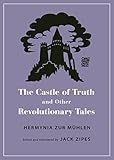The Castle of Truth and Other Revolutionary Tales / Hermynia Zur Mühlen; ed. by Jack Zipes.
Material type: TextSeries: Oddly Modern Fairy Tales ; 16Publisher: Princeton, NJ : Princeton University Press, [2020]Copyright date: ©2020Description: 1 online resource (216 p.) : 17 b/w illusContent type:
TextSeries: Oddly Modern Fairy Tales ; 16Publisher: Princeton, NJ : Princeton University Press, [2020]Copyright date: ©2020Description: 1 online resource (216 p.) : 17 b/w illusContent type: - 9780691201252
- 9780691201269
- Child rearing -- United States
- Early childhood education -- United States
- Parental overprotection
- Parenting -- United States
- Self-reliance in children
- LITERARY CRITICISM / General
- A. S. Byatt
- Ali, der Teppichweber
- Ali, the Carpet Weaver
- An den Ufern des Hudsons
- Charles Perrault
- Children’s literature
- Der junge Genosse
- Die Söhne der Aischa
- Die blaue Strahl
- Die rote Fahne
- Die weiße Pest
- E.T.A. Hoffmann
- Ein Jahr im Schatten
- Es war enimal, und es wird sein
- Im Schatten des elektrischen Stuhls
- In the Shadow of the Electric Chair
- Lawrence Desberry
- Lina
- Lionel Gossman
- Little Allies
- Malik Verlag
- Marina Warner
- Michael Rosen
- Naomi Mitcheson
- Nora Has a Great Idea
- Nora hat eine famose Idee
- On the Bank of the Hudson River
- Once Upon a Time, It Will Be
- One Year in Shadows
- Our Daughters, the Nazis
- Philip Pullman
- Said, der Träumer
- Said, the Dreamer
- Schupomann Karl Müller
- Stephen Millhauser
- The Blue Ray
- The Fourth Pig
- The Red Flag
- The Sons of Aiescha
- The White Plague
- The Young Comrade
- Traugott Lehmann
- Unsere Töchter, die Nazinen
- Weimar Germany
- Weimar era
- Weimar literature
- What Little Peter’s Friends Tell Him
- Workers’ Tales
- children’s books
- fables
- folklore
- folklorist
- left-wing literature
- socialist literature
- working-class literature
- 833/.912 23
- PT2653.U7
- online - DeGruyter
| Item type | Current library | Call number | URL | Status | Notes | Barcode | |
|---|---|---|---|---|---|---|---|
 eBook
eBook
|
Biblioteca "Angelicum" Pont. Univ. S.Tommaso d'Aquino Nuvola online | online - DeGruyter (Browse shelf(Opens below)) | Online access | Not for loan (Accesso limitato) | Accesso per gli utenti autorizzati / Access for authorized users | (dgr)9780691201269 |
Browsing Biblioteca "Angelicum" Pont. Univ. S.Tommaso d'Aquino shelves, Shelving location: Nuvola online Close shelf browser (Hides shelf browser)

|

|

|

|

|

|

|
||
| online - DeGruyter The Hidden Curriculum : First Generation Students at Legacy Universities / | online - DeGruyter Kierkegaard's Journals and Notebooks, Volume 11, Part 1 : Loose Papers, 1830-1843 / | online - DeGruyter Rediscovering the Islamic Classics : How Editors and Print Culture Transformed an Intellectual Tradition / | online - DeGruyter The Castle of Truth and Other Revolutionary Tales / | online - DeGruyter What Happens When We Practice Religion? : Textures of Devotion in Everyday Life / | online - DeGruyter Comparing the Literatures : Literary Studies in a Global Age / | online - DeGruyter Patterns of Development in Latin America : Poverty, Repression, and Economic Strategy / |
Frontmatter -- Contents -- List of Illustrations -- Acknowledgments -- Introduction -- A Note on the Illustrators -- Tales -- Bibliography
restricted access online access with authorization star
http://purl.org/coar/access_right/c_16ec
A collection of radical political fairy tales—some in English for the first time—from one of the great female practitioners of the genreHermynia Zur Mühlen (1883–1951), one of the twentieth century’s great political writers, was not seemingly destined for a revolutionary, unconventional literary career. Born in Vienna to an aristocratic Catholic family, Zur Mühlen married an Estonian count. But she rebelled, leaving her upper-class life to be with the Hungarian writer and Communist Stefan Klein, and supporting herself through translations and publications. Altogether, Zur Mühlen wrote thirty novels, mysteries, and story collections, and translated around 150 works, including those of Upton Sinclair, John Galsworthy, and Edna Ferber. A wonderful new addition to the Oddly Modern Fairy Tales Series, The Castle of Truth and Other Revolutionary Tales presents English readers with a selection of Zur Mühlen’s best political fairy tales, some translated from German for the first time.In contrast to the classical tales of the Brothers Grimm and Hans Christian Andersen, Zur Mühlen’s candid, forthright stories focus on social justice and the plight of the working class, with innovative plots intended to raise the political consciousness of readers young and old. For example, in “The Glasses,” readers are encouraged to rip off the glasses that deceive them, while in “The Carriage Horse,” horses organize a union to resist their working and living conditions. In “The Broom,” a young worker learns how to sweep away injustice.With an informative introduction by Jack Zipes and period illustrations by George Grosz, John Heartfield, Heinrich Vogeler, and Karl Holtz, The Castle of Truth and Other Revolutionary Tales revives the legacy of a notable female artist whose literary and political work remains relevant in our own time.
Mode of access: Internet via World Wide Web.
In English.
Description based on online resource; title from PDF title page (publisher's Web site, viewed 25. Jun 2024)


